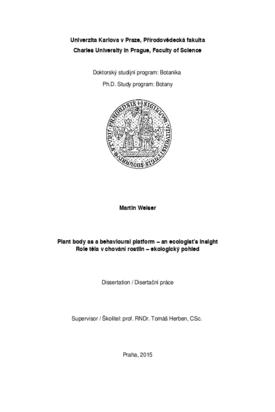Plant body as a behavioural platform - an ecologist's insight
Role těla v chování rostlin - ekologický pohled
dizertační práce (OBHÁJENO)

Zobrazit/
Trvalý odkaz
http://hdl.handle.net/20.500.11956/79707Identifikátory
SIS: 85014
Kolekce
- Kvalifikační práce [19109]
Autor
Vedoucí práce
Oponent práce
Šmilauer, Petr
Novoplansky, Ariel
Fakulta / součást
Přírodovědecká fakulta
Obor
-
Katedra / ústav / klinika
Katedra botaniky
Datum obhajoby
8. 9. 2015
Nakladatel
Univerzita Karlova, Přírodovědecká fakultaJazyk
Angličtina
Známka
Prospěl/a
Souhrn Rostliny rostou. Porovnáváme-li jedince (rostlin) se stejnou sadou vloh, najdeme rozdíly dvou typů: jedny lze předem předpovědět podle toho, do jaké velikosti jedinci narostli, druhý typ rozdílů je dán tím, jakým způsobem narostli, a lze jej předpovědět s menší jistotou. Způsob růstu, který rostlina zvolí, je vlastně jejím chováním. Takto nahlížený růst dovolí předvídat výsledky interakcí jedinců či prostředí, kde lze s takovým chováním (zvolenou formou růstu) uspět. Na druhou stranu, prostor pro možné chování omezují vlohy jedinců, a ačkoliv se jedinci vlohami liší obecně, větší rozdíly lze očekávat mezi málo příbuznými jedinci, kteří nemohou dát vzniknout potomkům s kombinacemi svých vloh. Právě možnost soužití takových skupin jedinců, tedy druhů, je předmětem zájmu ekologie společenstev. V této práci se snažím ukázat, jak souvisí chování příslušníků druhu s jejich společnými, druhovými, vlastnostmi. Protože jde o rostliny, zaměřil jsem se na vlastnosti jejich těl, jakožto výsledků a současně platforem růstu. Tím se pokouším poskytnout pravidla (korelativní povahy), která by v důsledku umožnila spojit vlastnosti těl druhů s jejich soužitím, je-li soužití druhů závislé na jejich chování. Tato práce obsahuje čtyři takové studie a každá z nich se věnuje jinému okruhu vlastností druhů a jejich vlivu na...
Conceptualisation of plant behaviour, or plant phenotypic plasticity, has been proven to be useful both on the ecosystem scale and on the level of individuals, as it allows to predict differentiation of species across ecosystems or results of interactions among individuals. Between these extremes is a vast array of processes that drive community assembly. These processes are difficult to predict, be it at the individual level or based on whether a whole species is plastic or non-plastic. These processes are traditionally investigated at the species level. In this thesis, however, I instead show how species-specific life histories delineate plant behaviour. I hope to convince the reader that it is the plant body, or at least its species-specific properties, not merely its non-specific, theoretical degree of plasticity, that should be used to explain actual cases where plant behaviour underpins species coexistence. As evidence for my case, I present four studies, each of them dealing with different part of the plant body that underlies different aspects of plant behaviour. In the first study, I show how species' life- history traits are coordinated with their responses to neighbour presence and resource shortage, both of these delivered in the form of changing light quantity and quality. Not only the...
